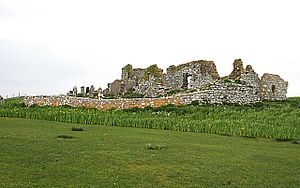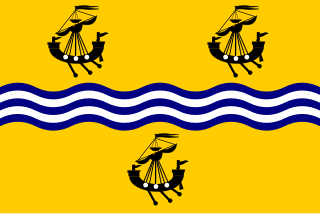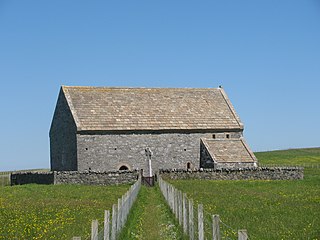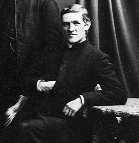
Teampull na Trionaid ("trinity church") is a ruined 13th-century Augustinian nunnery at Carinish, on North Uist, in the Outer Hebrides of Scotland.

Teampull na Trionaid ("trinity church") is a ruined 13th-century Augustinian nunnery at Carinish, on North Uist, in the Outer Hebrides of Scotland.
According to Bill Lawson, an entry in the Red Book of Clanranald reads, Beathog inghen Shomhuirle do bhi na mnaoi riagalta & na cailligh duibh. Also do thoguibh Teampall Chairinis anuibhist. [1]
"Beathag, daughter of Somerled, was a religious woman and a Black Nun. It is she that erected Teampall Chairinis in Uist." [1]
Bill Lawson writes, "It is known that Beathag was prioress of Iona in about 1203, the only problem in the ascription to her being that the Islands were still under Norse rule, though of course many of the Norse families would have become Christianized by then." [1]
Amie mac Ruari is said to have rebuilt the church in the 14th century after her divorce from John of Islay, Lord of the Isles. [2]
In 1389, Godfrey, the son of John of Islay and Amie Mac Ruari, confirmed a grant to the Abbey of Inchaffray by his mother's aunt Christina of Sancta Trinita in Chairinis, so the original grant must have been at least two generations before. [3]
During the Scottish Reformation, however, the families of Roman Catholic priests and those of the tacksmen and Clan Chiefs all attempted to claim Church lands for their own. [4] Since then, the convent has been in ruins.
The Battle of Carinish, which was fought between the warriors of Clan MacDonald of Sleat and Clan MacLeod of Dunvegan, took place near the ruins of the nunnery in 1601.
According to Bill Lawson, "It is said that the Teampull in its early days was a college of learning - even that it was the first university." [1]
John Lorne Campbell has written, however, that by the lifetime of North Uist Bard John MacCodrum (1694-1779), the statement that a Scottish Gael was "illiterate" meant only that they couldn't read or write in English. According to Campbell, "In MacCodrum's day little education was available for the Highlanders, and none at all in their own language." [5]
According to Bill Lawson, "T.S. Muir stated in 1867 that he was told 'that one Macpherson, an octogenarian living at Cladach Cairinis, remembers having seen, when a boy, stones figured with angels, armed men, animals, etc.' This must have been John MacPherson -- Iain Mac Eoghainn - whose descendants still live in the township. The description of the stones suggests something like the scene s on the tomb of Alasdair Crotach MacLeod in St. Clement's Church in Roghadal in Harris, but any such stones have long since disappeared. Alexander Carmichael surmises that, being of freestone, they were carried away for sharpening stones. Carmichael also states that there was formerly a pinnacle on the east gable, with the figure of a three-headed giant on the top, presumably representing the Trinity, but that too had long gone. One stone, carved in the shape of a human head, has been preserved, and is now in the museum of Taigh Chearsabhagh in Loch nam Madadh." [6]
Rev. Kenneth MacLeod of Gigha, who collaborated with Marjory Kennedy-Fraser in collecting Scottish Gaelic songs, wrote in 1907, "In the early days of the nineteenth century, the North Uist people, on a day still spoken of, reverently laid in their Temple of the Trinity an unknown body washed ashore by the flowing tide: at twilight a mysterious-looking barge glided into the bay, three of its crew marched up silently to the temple, opened the newly-made grave, carried off the body, and then disappeared forever into the darkness and the great open sea." [7]
The ruins are protected as a scheduled monument. [8]

The Outer Hebrides or Western Isles, sometimes known as the Long Isle or Long Island, is an island chain off the west coast of mainland Scotland. The islands are geographically coextensive with Comhairle nan Eilean Siar, one of the 32 unitary council areas of Scotland. They form part of the archipelago of the Hebrides, separated from the Scottish mainland and from the Inner Hebrides by the waters of the Minch, the Little Minch, and the Sea of the Hebrides.

Harris is the southern and more mountainous part of Lewis and Harris, the largest island in the Outer Hebrides, Scotland. Although not an island itself, Harris is often referred to in opposition to the Isle of Lewis as the Isle of Harris, which is the former postal county and the current post town for Royal Mail postcodes starting HS3 or HS5.

North Uist is an island and community in the Outer Hebrides of Scotland.

South Uist is the second-largest island of the Outer Hebrides in Scotland. At the 2011 census, it had a usually resident population of 1,754: a decrease of 64 since 2001. The island, in common with the rest of the Hebrides, is one of the last remaining strongholds of the Gaelic language in Scotland. South Uist's inhabitants are known in Gaelic as Deasaich (Southerners). The population is about 90% Roman Catholic.

Trotternish or Tròndairnis is the northernmost peninsula of the Isle of Skye, in Scotland. Its most northerly point, Rubha Hùinis, is the most northerly point of Skye.

Bragar is a village on the west side of the Isle of Lewis in the Outer Hebrides, Scotland, 14 miles from the island's only town, Stornoway. Bragar is within the parish of Barvas, and is situated on the A858 between Carloway and Barvas.

Howmore lies on the island of South Uist to the southwest of Loch Druidibeg. The mountain of Haarsal rises to 139 m (456 ft) to the east and immediately south is the smaller settlement of Howbeg. Howmore is also within the parish of South Uist.

Carinish, is a hamlet on North Uist, in the Outer Hebrides, Scotland. It is in the south of the island, about two miles from the causeway to Benbecula. The hamlet is known for the Carinish Stone Circle and the Trinity Temple. Carinish is within the parish of North Uist and is situated on the A865.

Clan Macfie is a Highlands Scottish Clan.

St Moluag's church is a church in the village of Eoropie in Ness in the Isle of Lewis in Scotland. It is one of the busiest visitor attractions in Ness, due to historical importance and because it is easily accessible from the road along a footpath.
Garmoran is an area of western Scotland. It lies at the south-western edge of the present Highland Region. It includes Knoydart, Morar, Moidart, Ardnamurchan, and the Small Isles.

Swainbost is a village on the Isle of Lewis in the district of Ness, in the Outer Hebrides, Scotland. The name Swainbost meaning Sweins steading is of Viking derivation. The settlement is situated in the parish of Barvas. According to Ronald Black, Swainbost was re-settled during the Highland Clearances in 1842. The island's Anglo-Scottish landlord had expected the crofters evicted from Uig to emigrate and only reluctantly granted them land at Swainbost to avert the threat of violence.

The Battle of Coire na Creiche was a Scottish clan battle fought on the Isle of Skye in 1601. It was the culmination of a year of feuding between Clan MacLeod of Dunvegan and the Clan MacDonald of Sleat, that ended with a MacDonald victory in Coire na Creiche on the northern slopes of the Cuillin hills. It was the last clan battle in Skye.
Dòmhnall Ruadh Chorùna, legally Donald MacDonald or Dòmhnall MacDhòmhnaill, was a Scottish Gaelic Bard, North Uist stonemason, and veteran of the First World War. Literary historian Ronald Black has called Dòmhnall Ruadh, "The Voice of the Trenches."

The Battle of Carinish was a Scottish clan battle fought in North Uist in 1601. It was part of a year of feuding between Clan MacLeod of Dunvegan and the Clan MacDonald of Sleat, that ended with a MacDonald victory and an enforced peace.

The Reverend Allan MacDonald was a Scottish Roman Catholic priest during the Victorian era. During the later phases of the Highland Clearances, Fr. MacDonald was also an activist for the reform of the absolute power granted to Anglo-Scottish landlords to both rackrent and evict their tenants en masse and at will under Scots property law. Furthermore, Father Allan MacDonald was a radically innovative poet with a permanent place in the literary canon of Scottish Gaelic literature and a nationally respected folklorist and collector from the oral tradition in the Scottish Highlands and Islands.
Amy of Garmoran also known as Amie MacRuari and Euphemia was a 14th-century Scottish noblewoman who was the sister of Raghnall mac Ruaidhri, Lord of Garmoran and the spouse of John of Islay. After her marriage had produced three sons, the ambitious John of Islay divorced her in order to remarry and cement his links with the House of Stewart. She then retired to her estates in the Highlands and Islands, and completed various ecclesiastical and other building projects. Her son Ranald was the progenitor of Clanranald.

Bethóc ingen Somairle was a 13th-century Scottish prioress, considered to have been the first of Iona Nunnery. She was a daughter of Somairle mac Gilla Brigte.

Description of the Western Isles of Scotland is the oldest known account of the Hebrides and the Islands of the Clyde, two chains of islands off the west coast of Scotland. The author was Donald Monro, a clergyman who used the title of "Dean of the Isles" and who lived through the Scottish Reformation. Monro wrote the original manuscript in 1549, although it was not published in any form until 1582 and was not widely available to the public in its original form until 1774. A more complete version, based on a late 17th-century manuscript written by Sir Robert Sibbald, was first published as late as 1961. Monro wrote in Scots and some of the descriptions are difficult for modern readers to render into English. Although Monro was criticised for publishing folklore and for omitting detail about the affairs of the churches in his diocese, Monro's Description is a valuable historical account and has reappeared in part or in whole in numerous publications, remaining one of the most widely quoted publications about the western islands of Scotland.
Iain Mac Fhearchair (1693-–1779) was a Scottish Gaelic-speaking Bard and seanchaidh "who lived and died in the island of North Uist." Later in his life, Iain served as Chief Bard to the Chief of Clan MacDonald of Sleat.